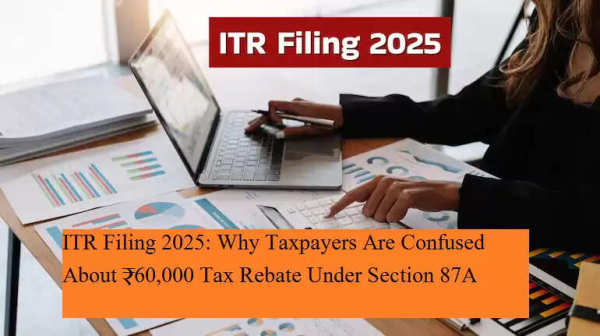
The income tax return (ITR) filing season for Assessment Year (AY) 2025-26 is in full swing, but many taxpayers are caught in a web of confusion over the much-talked-about ₹60,000 rebate under Section 87A. Budget 2025 announcements have created mixed signals, leaving several individuals uncertain about whether they can claim this higher tax relief while filing their current returns.
Why the Confusion Around ₹60,000 Rebate?
The primary reason for the misunderstanding stems from the Union Budget 2025, where the government enhanced the rebate under Section 87A to ₹60,000 for taxpayers under the new tax regime. This change was introduced to make the simplified tax system more appealing. However, the crucial detail many taxpayers are missing is that this revised rebate is applicable from Financial Year (FY) 2025-26, corresponding to Assessment Year (AY) 2026-27.
In other words, the ₹60,000 relief is not available for the current ITR filing cycle for FY 2024-25 (AY 2025-26). Despite this, several taxpayers are mistakenly trying to claim the higher rebate in the returns being filed this year, leading to potential filing errors or incorrect refund expectations.
What Does Section 87A Offer Currently?
Section 87A of the Income Tax Act provides relief to resident individual taxpayers with income below a prescribed threshold. This rebate is applied to the tax payable after the total tax liability is calculated.
Here’s how the rebate currently works:
-
Old Tax Regime: Maximum rebate of ₹12,500 for taxable income up to ₹5 lakh.
-
New Tax Regime: Maximum rebate of ₹25,000 for taxable income up to ₹7 lakh.
Effectively, this means that a resident individual opting for the new regime and earning up to ₹7 lakh can bring their tax liability down to zero, while in the old regime, full tax exemption is limited to an income of ₹5 lakh.
What Changes Were Announced in Budget 2025?
To make the new tax regime more attractive, the Finance Minister announced a significant revision:
-
From FY 2025-26 (AY 2026-27), the maximum rebate under Section 87A will increase to ₹60,000.
-
Taxpayers with taxable income up to ₹12 lakh will be eligible for this enhanced rebate.
-
With the standard deduction of ₹75,000 under the new regime, individuals earning up to ₹12.75 lakh annually could end up with zero tax liability.
However, it is essential to remember that these changes are not applicable for the ITR currently being filed for FY 2024-25.
Key Points to Remember While Filing ITR 2025
-
The current ITR filing applies to FY 2024-25 (AY 2025-26), where the old rebate limits are still in effect.
-
The ₹60,000 rebate under Section 87A will apply only from FY 2025-26.
-
The rebate is available only to resident individual taxpayers and does not apply to non-residents.
-
This rebate cannot be applied against long-term or short-term capital gains.
-
Compare the old and new tax regimes carefully before filing, to maximize savings.
Bottom Line
The Section 87A rebate is a critical relief tool for middle-class taxpayers. While the enhanced ₹60,000 rebate announced in Budget 2025 promises bigger savings, taxpayers must wait until next year’s ITR filing cycle to benefit. For now, returns for AY 2025-26 must follow the existing rebate structure—₹12,500 in the old regime and ₹25,000 in the new regime.
Filing ITR with the correct understanding of these rules is essential to avoid miscalculations, unnecessary delays, or refund mismatches. Staying informed ensures smooth compliance and helps maximize the benefits available under the law.
-
Ukraine: Russia bombed Kyiv again, 26 people including a 2-year-old child died

-
Since September 2023, around 1.2 million Afghans have returned from Pakistan, according to the UNHCR

-
WHO extends international travel restrictions on Pakistan for another three months due to WPV1

-
** Just one piece alum and money will start raining! This mysterious remedy changed the fate of thousands **

-
World Breastfeeding Week: Know the correct answer to 10 questions related to breastfeeding from experts
